- Joined
- 1 February 2011
- Messages
- 2,615
- Reaction score
- 2,556
Not long ago I've finished drawing the various Amagi/Akagi carrier designs I've found in the Hiraga archive.
So I post them here now:
Amagi Aircraft Carrier Preliminary Design 1
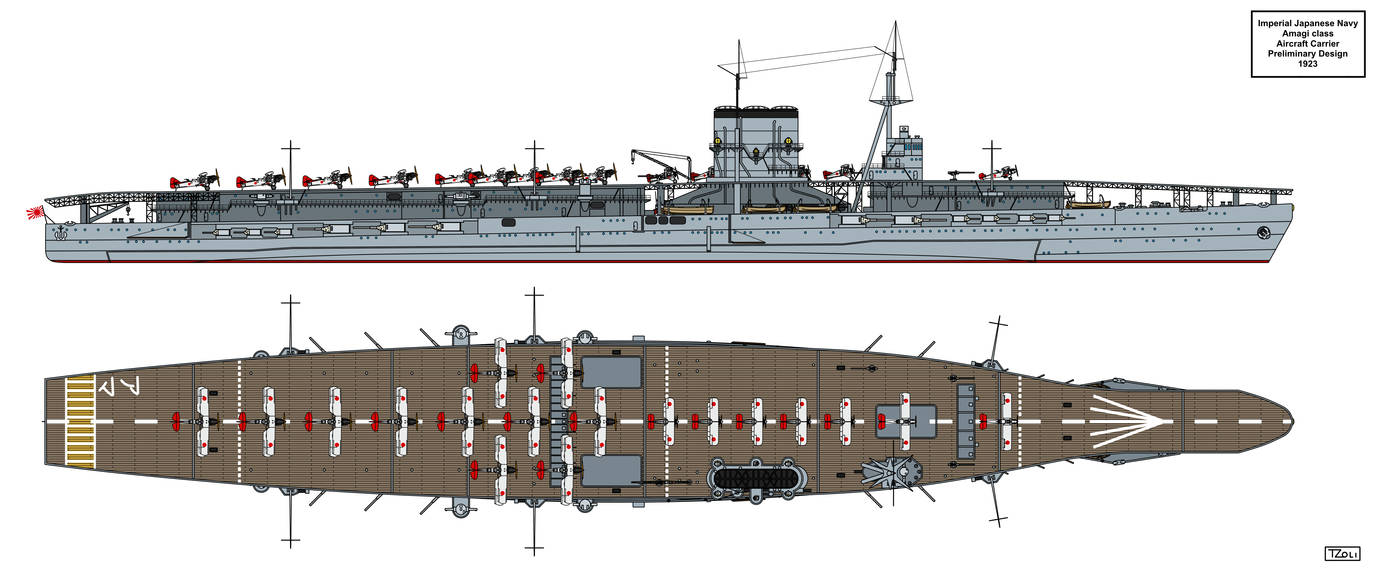
 www.deviantart.com
www.deviantart.com

This is something different from all those battleship designs from Vickers to Argentina.
One of the preliminary proposals to convert the Amagi class Battlecruisers IJN Amagi and Akagi to aircraft carriers.
This is most likely an early implementation because the hanger capacity was only for 36 torpedo bomber sized aircraft (Mitsubishi B1M) and there is a large unoccupied space around the funnel uptake. There are 7 hangers distributed among 3 hanger spaces in the hull: One forward for 4 aircrafts (No.1), one aft for 22 aircrafts (No.2-4) and one below the after one (No.5-7) for 10 aircrafts.
The most prominent difference between this design and what actually became the Akagi are the large Funnel reminiscent of the USN's Lexington class, a bridge superstructure separated from the funnel, four single 12cm AA guns on the flight deck rather twins on sponsons on the side, nne deck higher main deck for housing the crew but the flight deck was still lower in height then in the Akagi, and more numerous casemated battery: All 20cm guns in casemates with an extra 7x 12cm on each side.
While the data page shows 36 bomber aircrafts as it's air group I've instead made a mixed group based on the hangers:
4x Mitsubishi C1M Scout planes
10x Nakajima A1N Fighters
22x Mitsubishi B1M Bombers
The design had the following characteristics:
Dimensions: 235 (pp) 249 (wl) 258,2m (oa) x 33,5 (at bulges) x 6,58m
Displacement: 29.600tons (standard), 33.000tons (full load)
Armour: 127mm Belt, 79mm Deck
Engines: 131.200shp, Gihon steam turbines, 4 shafts
Range: 14.800km at 26km/h (8.000nm at 14knots)
Speed: 57km/h (31,75knots)
Armaments:
10x1 20cm/50 Type 3 (3rd Year Type No.1) Casemated Guns
14x1 12cm/45 Type 10 (10th Year Type) Casemated Guns
4x1 12m/45 Type 10 (10th Year Type) AA Guns
Aircraft capacity: 36 planes
Original drawing:
 iiif.dl.itc.u-tokyo.ac.jp
Data page:
iiif.dl.itc.u-tokyo.ac.jp
Data page:
Amagi Aircraft Carrier Preliminary Design 2
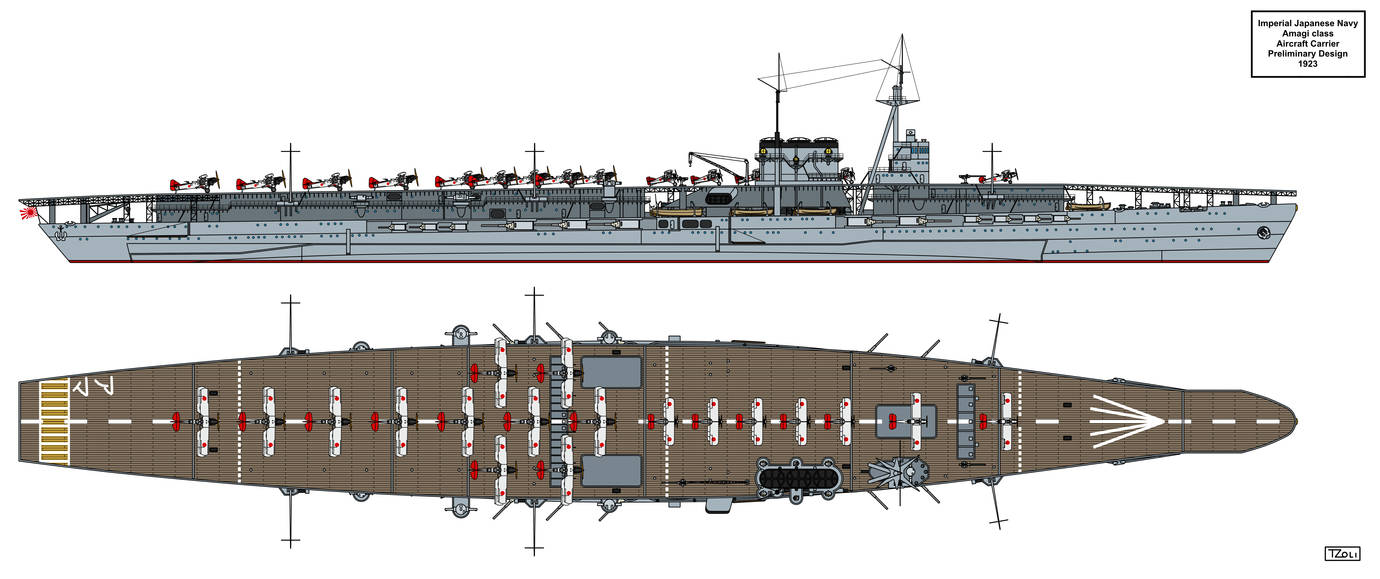
 www.deviantart.com
www.deviantart.com

This is a somewhat different version of the other preliminary design for IJN Amagi and Akagi above
The changes are noticeable:
Shorter funnel as well as slightly smaller and moved well forward, the casemated guns moved much closer to the centre of the ship possibly to improve their effectiveness in rough weather though they are still higher then on Akagi as built.
A longer and fuller (forward) flight deck, though it's height further reduced. The AA guns moved slightly forward and while the original drawing does not show a bridge, the angle of fire of the forward AA guns as well as the existence of the funnel meant there should had been one. Though it was possible it was moved under deck on the sides to further reduce topweight.
Stern similar to Akagi as built eg a cruiser type stern rather a straight stern.
The design had the following characteristics:
Dimensions: 235 (pp) 248 (wl) 264,5m (oa) x 33,5 (at bulges) x 6,58m
Displacement: 29.600tons (standard), 33.000tons (full load)
Armour: 127mm Belt, 79mm Deck
Engines: 131.200shp, Gihon steam turbines, 4 shafts
Range: 14.800km at 26km/h (8.000nm at 14knots)
Speed: 57km/h (31,75knots)
Armaments:
10x1 20cm/50 Type 3 (3rd Year Type No.1) Casemated Guns
14x1 12cm/45 Type 10 (10th Year Type) Casemated Guns
4x1 12m/45 Type 10 (10th Year Type) AA Guns
Aircraft capacity: 36 planes (probably)
Original drawing:
Data page:
Amagi Aircraft Carrier Preliminary Design 3
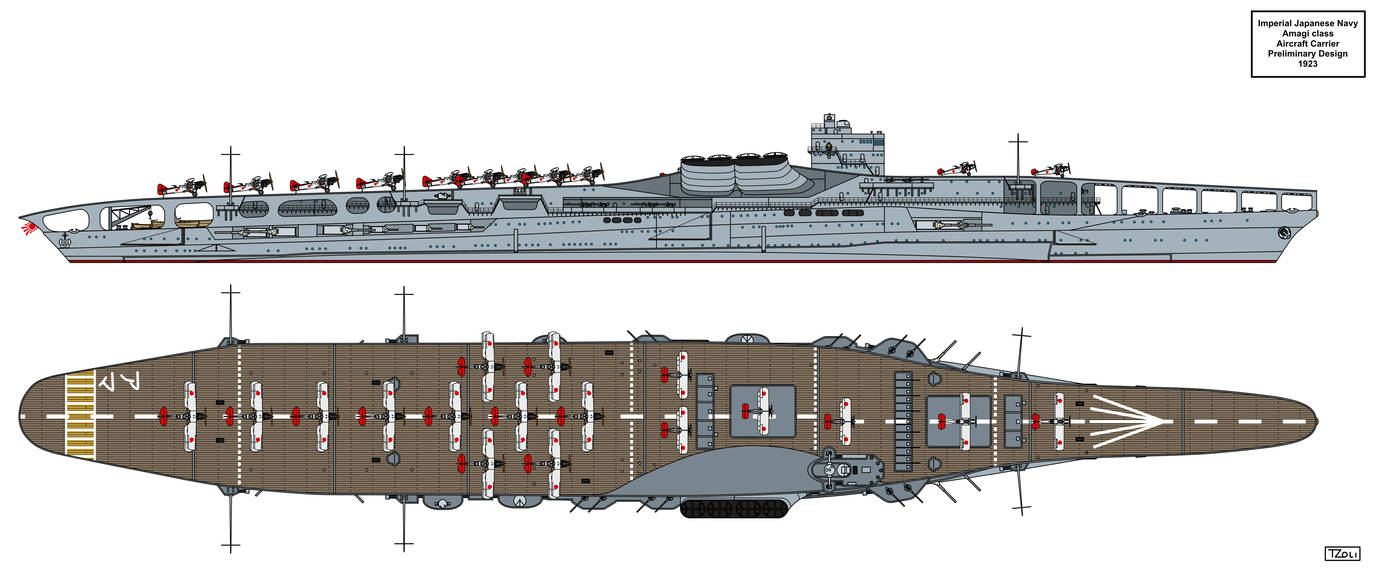
 www.deviantart.com
www.deviantart.com

This is yet another design of the Amagi class carrier conversion proposals and one of the most unique ones with it's large armoured funnel casing blending outward from the flight deck. Still you can see many aspects which were integrated into the final Akagi the aft positions of the casemates finalised, one single large outward angled funnel, final number of 6x 12cm AA guns per side and flight deck size closing that of the final design.
The design had the following characteristics:
Dimensions: 235 (pp) 248 (wl) 268,5m (oa) x 38 (at sponsons and funnel) x 6,58m
Displacement: 29.600tons (standard), 33.000tons (full load)
Armour: 127mm Belt, 79mm Deck
Engines: 131.200shp, Gihon steam turbines, 4 shafts
Range: 14.800km at 26km/h (8.000nm at 14knots)
Speed: 57km/h (31,75knots)
Armaments:
10x1 20cm/50 Type 3 (3rd Year Type No.1) Casemated Guns
6x1 12cm/45 Type 10 (10th Year Type) Casemated Guns
12x1 12m/45 Type 10 (10th Year Type) AA Guns
Aircraft capacity: 36-40 planes (probably)
Original drawing:
 iiif.dl.itc.u-tokyo.ac.jp
iiif.dl.itc.u-tokyo.ac.jp
Amagi Aircraft Carrier Preliminary Design 4
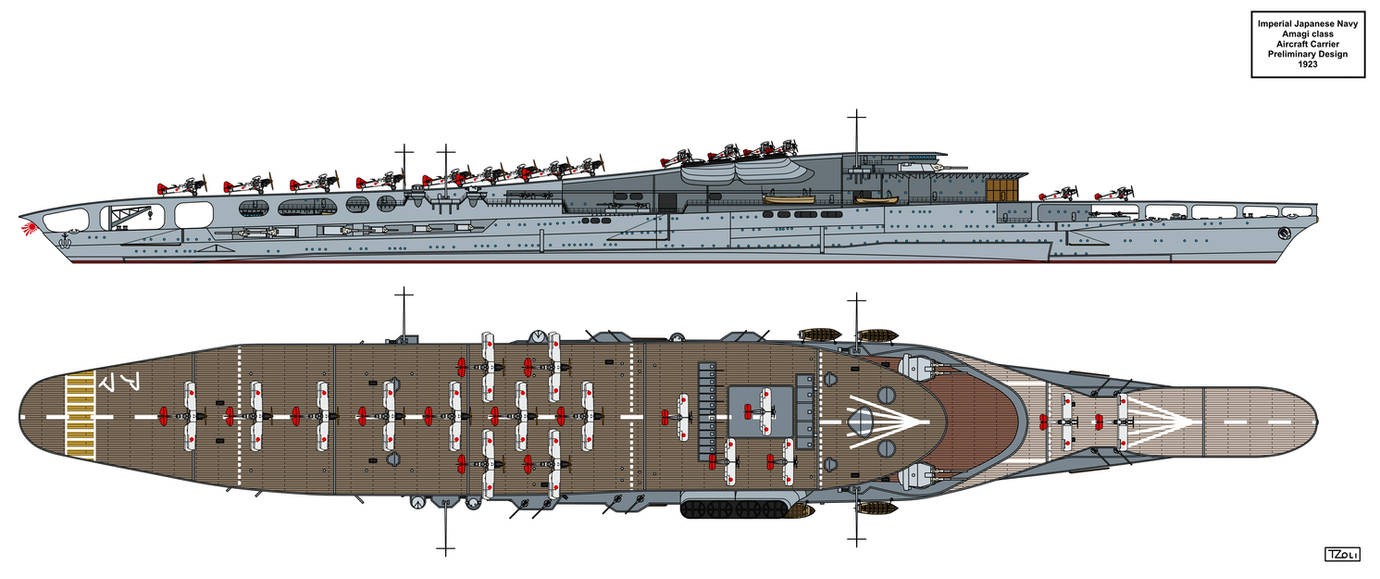
 www.deviantart.com
www.deviantart.com

This design is a refinement of the previous one.
By removing the bridge and angling the deck to fully overlap the funnel casing allowed a much larger deck space, on the other hand this seems to be the first design incorporating the idea of a multi deck carrier for the IJN.
This is twin deck carrier design as the the gun deck where the forward twin 20cm turrets are located are not high enough to efficiently operate aircraft (A fighter barely fits between the flight deck and the gun deck space)but this allowed a spacious space allocated for the command bridge.
The main or top flight deck might had been used for the launch of the first strike wave of aircraft, though primary mission was to recover the aircraft for which the almost ski-jump like angle could help slow and stop them, also the single elevator would suggest this mission as well.
The primary take off deck was on the lowest level just above the nose, though due to the AA gun placement there the take-off would be a bit more complicated in strong winds, as there are less space there.
While the original drawing does not show (but the one after this design does) it is logical to assume that the space for the bridge would also house the directors and rangefinder(s) of the main 20cm Guns which would also describe the funnels reduced height to be just barely above the flight deck and thus would not hamper the sight of the directors and rangefinder(s).
The design had the following characteristics:
Dimensions: 235 (pp) 248 (wl) 268,5m (oa) x 38 (at sponsons and funnel) x 6,58m
Displacement: 29.600tons (standard), 33.000tons (full load)
Armour: 127mm Belt, 79mm Deck
Engines: 131.200shp, Gihon steam turbines, 4 shafts
Range: 14.800km at 26km/h (8.000nm at 14knots)
Speed: 57km/h (31,75knots)
Armaments:
2x2 6x1 20cm/50 Type 3 (3rd Year Type No.1) Turreted and Casemated Guns
6x1 12cm/45 Type 10 (10th Year Type) Casemated Guns
12x1 12m/45 Type 10 (10th Year Type) AA Guns
Aircraft capacity: 36-40 planes
Original drawing:
https://iiif.dl.itc.u-tokyo.ac.jp/r...11b81#?c=0&m=0&s=0&cv=1&xywh=-659,0,8261,4927
Amagi Aircraft Carrier Preliminary Design 5
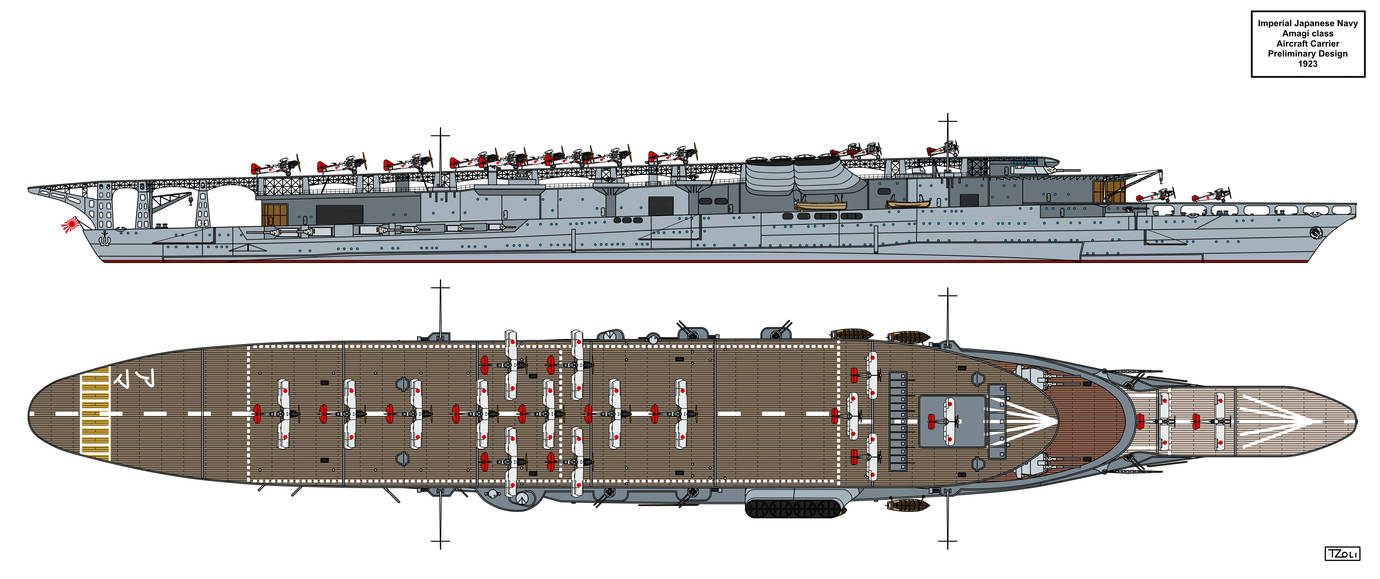
 www.deviantart.com
www.deviantart.com

With this next preliminary design the Amagi/Akagi got closer to it's final form. By fixing the large ski like flight deck of the previous design:

 www.deviantart.com
by moving the flight deck higher supported by beams and other structural elements the the landing of aircraft became much more simple and potentially more safe. In the same time the entire bridge part together with the twin turrets moved forward and the flight deck extended aft resulting in even more flight deck space for the aircraft. Armament wise the only change was the introduction of the twin 12cm DP-AA guns in open mounts on the same places as before eg 2 under the forward flying off deck, and 2-2 at each sides after the funnel.
www.deviantart.com
by moving the flight deck higher supported by beams and other structural elements the the landing of aircraft became much more simple and potentially more safe. In the same time the entire bridge part together with the twin turrets moved forward and the flight deck extended aft resulting in even more flight deck space for the aircraft. Armament wise the only change was the introduction of the twin 12cm DP-AA guns in open mounts on the same places as before eg 2 under the forward flying off deck, and 2-2 at each sides after the funnel.
A more refined version of this design exists where the after part of the flight deck squared off, the aft part of the hull cut one deck level and the arrangement of the AA guns became symmetrical.
You clearly see how the final Akagi evolved from these two designs, using the space below the flight deck for hangers and re-arranging the inner hangers structure and layout the capacity for aircraft could be doubled! The make the flight deck free from obstacles and fumes the funnel was bent down and sideways though this resulted the fumes reaching the port side AA guns hence the creation of the first fully enclosed DP-AA mount for the IJN.
The design had the following characteristics:
Dimensions: 235 (pp) 249 (wl) 275m (oa) x 39,5 (at sponsons and funnel) x 6,58m
Displacement: 29.600tons (standard), 33.000tons (full load)
Armour: 127mm Belt, 79mm Deck
Engines: 131.200shp, Gihon steam turbines, 4 shafts
Range: 14.800km at 26km/h (8.000nm at 14knots)
Speed: 57km/h (31,75knots)
Armaments:
2x2 6x1 20cm/50 Type 3 (3rd Year Type No.1) Turreted and Casemated Guns
6x1 12cm/45 Type 10 (10th Year Type) Casemated Guns
6x2 12m/45 Type 10 (10th Year Type) AA Guns
Aircraft capacity: 36-40 planes
Original drawing:
 iiif.dl.itc.u-tokyo.ac.jp
iiif.dl.itc.u-tokyo.ac.jp
 gazo.dl.itc.u-tokyo.ac.jp
Refined version:
gazo.dl.itc.u-tokyo.ac.jp
Refined version:
 gazo.dl.itc.u-tokyo.ac.jp
gazo.dl.itc.u-tokyo.ac.jp
So I post them here now:
Amagi Aircraft Carrier Preliminary Design 1

Amagi Aircraft Carrier Preliminary Design 1 by Tzoli on DeviantArt
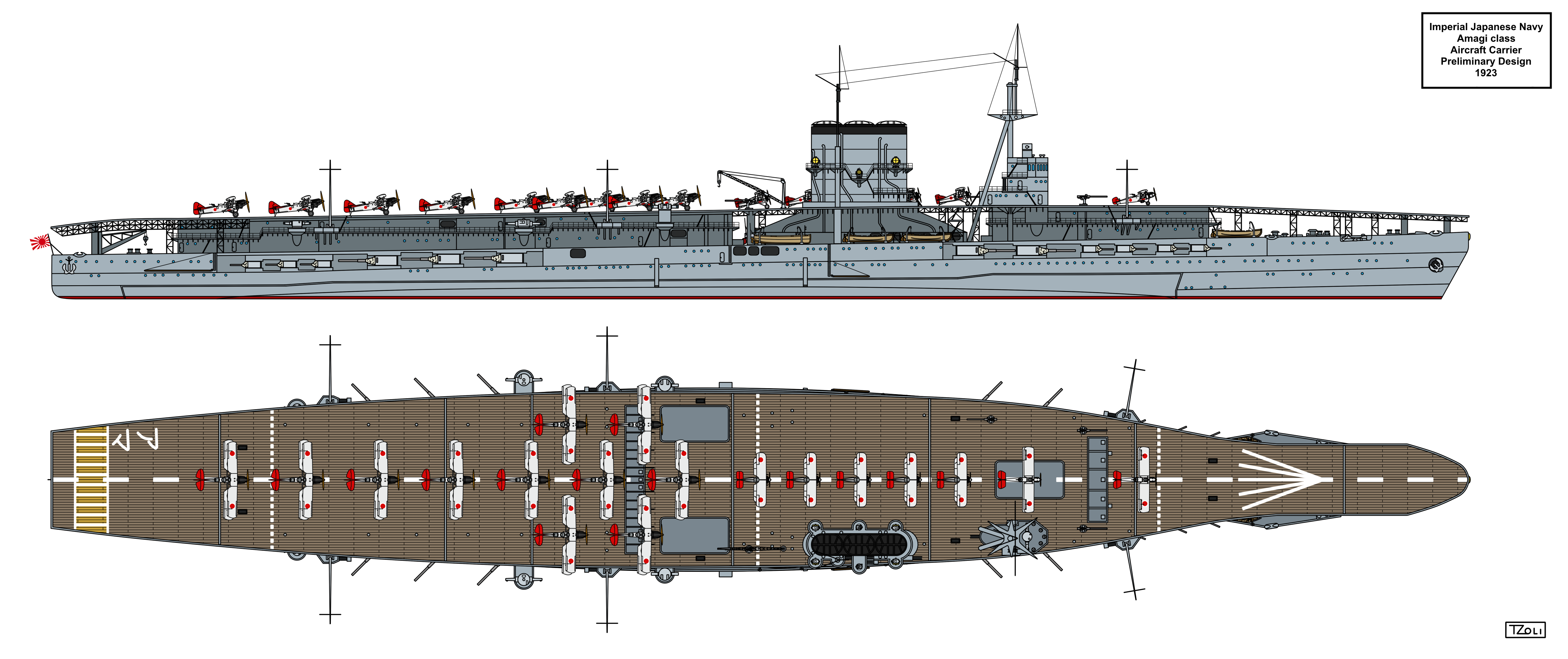
This is something different from all those battleship designs from Vickers to Argentina.
One of the preliminary proposals to convert the Amagi class Battlecruisers IJN Amagi and Akagi to aircraft carriers.
This is most likely an early implementation because the hanger capacity was only for 36 torpedo bomber sized aircraft (Mitsubishi B1M) and there is a large unoccupied space around the funnel uptake. There are 7 hangers distributed among 3 hanger spaces in the hull: One forward for 4 aircrafts (No.1), one aft for 22 aircrafts (No.2-4) and one below the after one (No.5-7) for 10 aircrafts.
The most prominent difference between this design and what actually became the Akagi are the large Funnel reminiscent of the USN's Lexington class, a bridge superstructure separated from the funnel, four single 12cm AA guns on the flight deck rather twins on sponsons on the side, nne deck higher main deck for housing the crew but the flight deck was still lower in height then in the Akagi, and more numerous casemated battery: All 20cm guns in casemates with an extra 7x 12cm on each side.
While the data page shows 36 bomber aircrafts as it's air group I've instead made a mixed group based on the hangers:
4x Mitsubishi C1M Scout planes
10x Nakajima A1N Fighters
22x Mitsubishi B1M Bombers
The design had the following characteristics:
Dimensions: 235 (pp) 249 (wl) 258,2m (oa) x 33,5 (at bulges) x 6,58m
Displacement: 29.600tons (standard), 33.000tons (full load)
Armour: 127mm Belt, 79mm Deck
Engines: 131.200shp, Gihon steam turbines, 4 shafts
Range: 14.800km at 26km/h (8.000nm at 14knots)
Speed: 57km/h (31,75knots)
Armaments:
10x1 20cm/50 Type 3 (3rd Year Type No.1) Casemated Guns
14x1 12cm/45 Type 10 (10th Year Type) Casemated Guns
4x1 12m/45 Type 10 (10th Year Type) AA Guns
Aircraft capacity: 36 planes
Original drawing:
平賀譲デジタルアーカイブ · 航空母艦天城大体配置図 · 東京大学学術資産等アーカイブズ共用サーバ
Amagi Aircraft Carrier Preliminary Design 2

Amagi Aircraft Carrier Preliminary Design 2 by Tzoli on DeviantArt
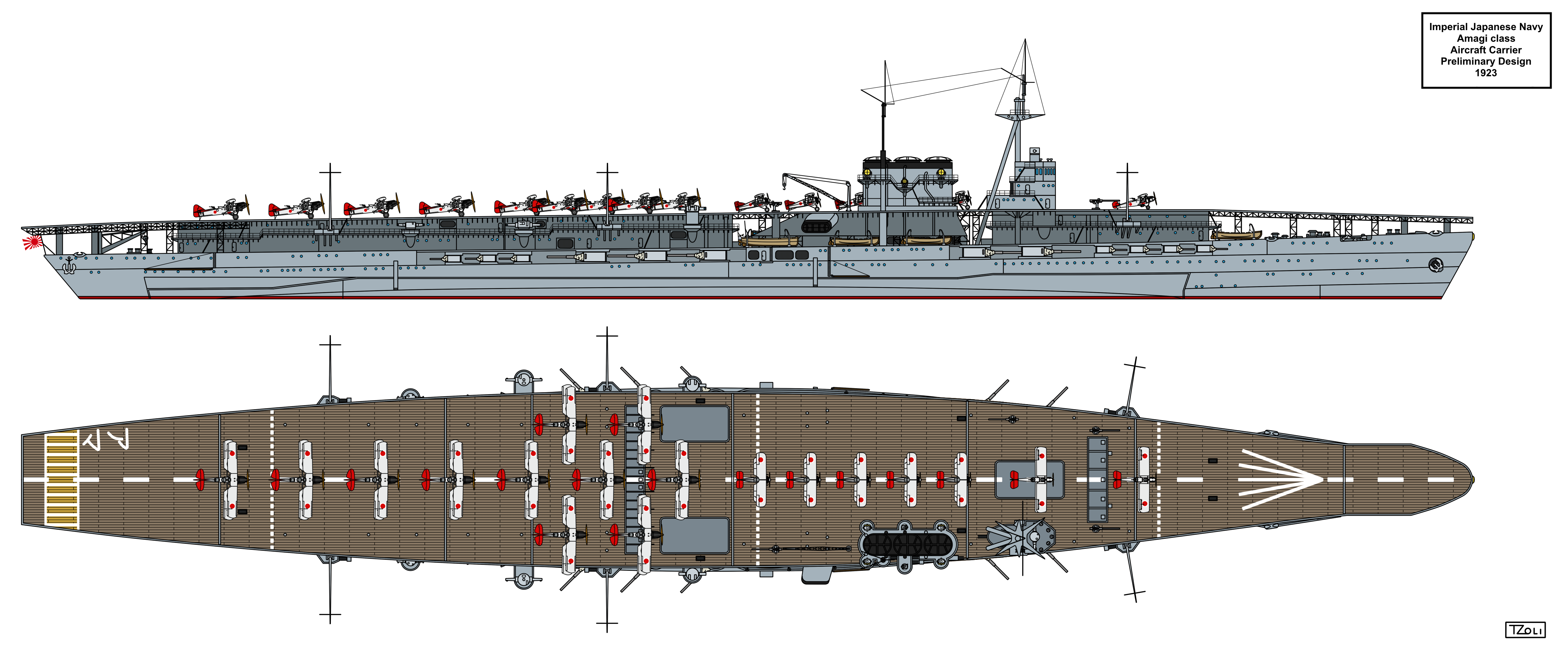
This is a somewhat different version of the other preliminary design for IJN Amagi and Akagi above
The changes are noticeable:
Shorter funnel as well as slightly smaller and moved well forward, the casemated guns moved much closer to the centre of the ship possibly to improve their effectiveness in rough weather though they are still higher then on Akagi as built.
A longer and fuller (forward) flight deck, though it's height further reduced. The AA guns moved slightly forward and while the original drawing does not show a bridge, the angle of fire of the forward AA guns as well as the existence of the funnel meant there should had been one. Though it was possible it was moved under deck on the sides to further reduce topweight.
Stern similar to Akagi as built eg a cruiser type stern rather a straight stern.
The design had the following characteristics:
Dimensions: 235 (pp) 248 (wl) 264,5m (oa) x 33,5 (at bulges) x 6,58m
Displacement: 29.600tons (standard), 33.000tons (full load)
Armour: 127mm Belt, 79mm Deck
Engines: 131.200shp, Gihon steam turbines, 4 shafts
Range: 14.800km at 26km/h (8.000nm at 14knots)
Speed: 57km/h (31,75knots)
Armaments:
10x1 20cm/50 Type 3 (3rd Year Type No.1) Casemated Guns
14x1 12cm/45 Type 10 (10th Year Type) Casemated Guns
4x1 12m/45 Type 10 (10th Year Type) AA Guns
Aircraft capacity: 36 planes (probably)
Original drawing:
Data page:
Amagi Aircraft Carrier Preliminary Design 3

Amagi Aircraft Carrier Preliminary Design 3 by Tzoli on DeviantArt
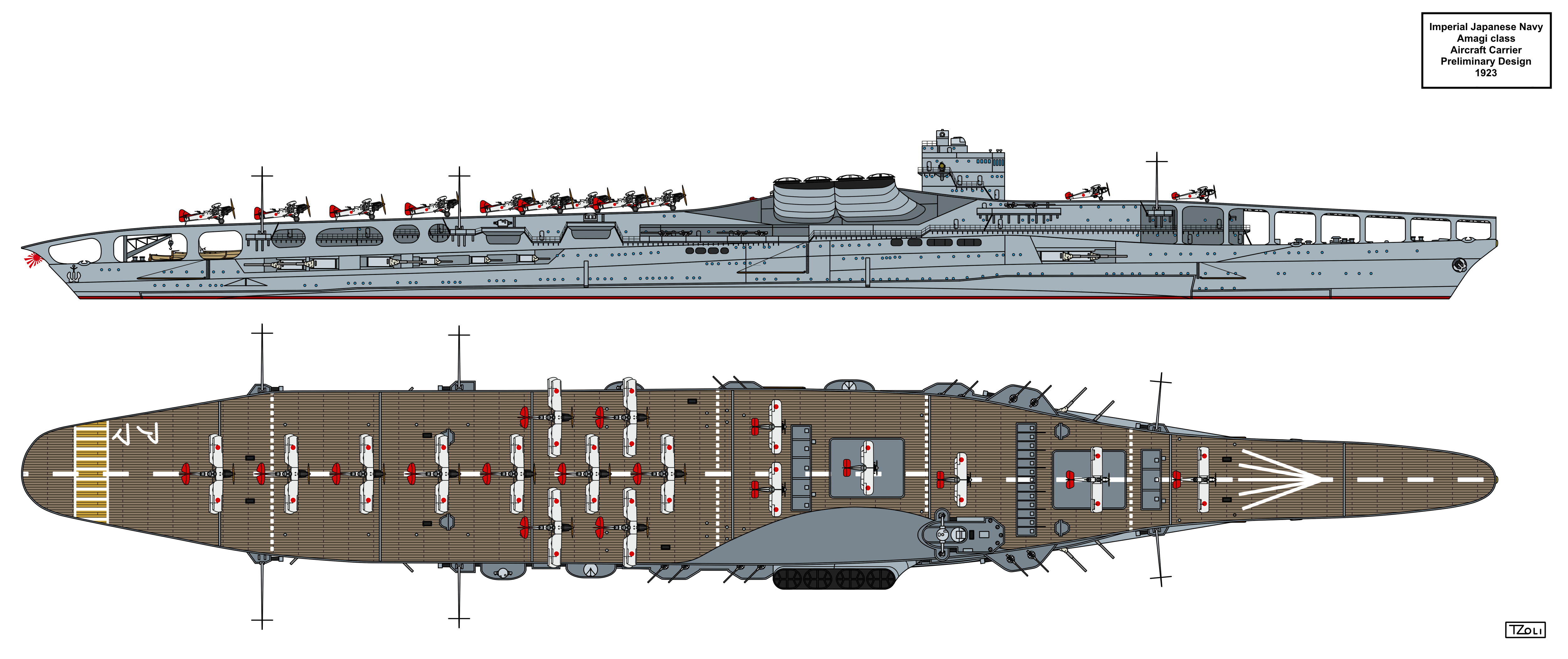
This is yet another design of the Amagi class carrier conversion proposals and one of the most unique ones with it's large armoured funnel casing blending outward from the flight deck. Still you can see many aspects which were integrated into the final Akagi the aft positions of the casemates finalised, one single large outward angled funnel, final number of 6x 12cm AA guns per side and flight deck size closing that of the final design.
The design had the following characteristics:
Dimensions: 235 (pp) 248 (wl) 268,5m (oa) x 38 (at sponsons and funnel) x 6,58m
Displacement: 29.600tons (standard), 33.000tons (full load)
Armour: 127mm Belt, 79mm Deck
Engines: 131.200shp, Gihon steam turbines, 4 shafts
Range: 14.800km at 26km/h (8.000nm at 14knots)
Speed: 57km/h (31,75knots)
Armaments:
10x1 20cm/50 Type 3 (3rd Year Type No.1) Casemated Guns
6x1 12cm/45 Type 10 (10th Year Type) Casemated Guns
12x1 12m/45 Type 10 (10th Year Type) AA Guns
Aircraft capacity: 36-40 planes (probably)
Original drawing:
平賀譲デジタルアーカイブ · 航空母艦天城・赤城艤装大体図〔第壱案・第弐案〕 · 東京大学学術資産等アーカイブズ共用サーバ
Amagi Aircraft Carrier Preliminary Design 4

Amagi Aircraft Carrier Preliminary Design 4 by Tzoli on DeviantArt
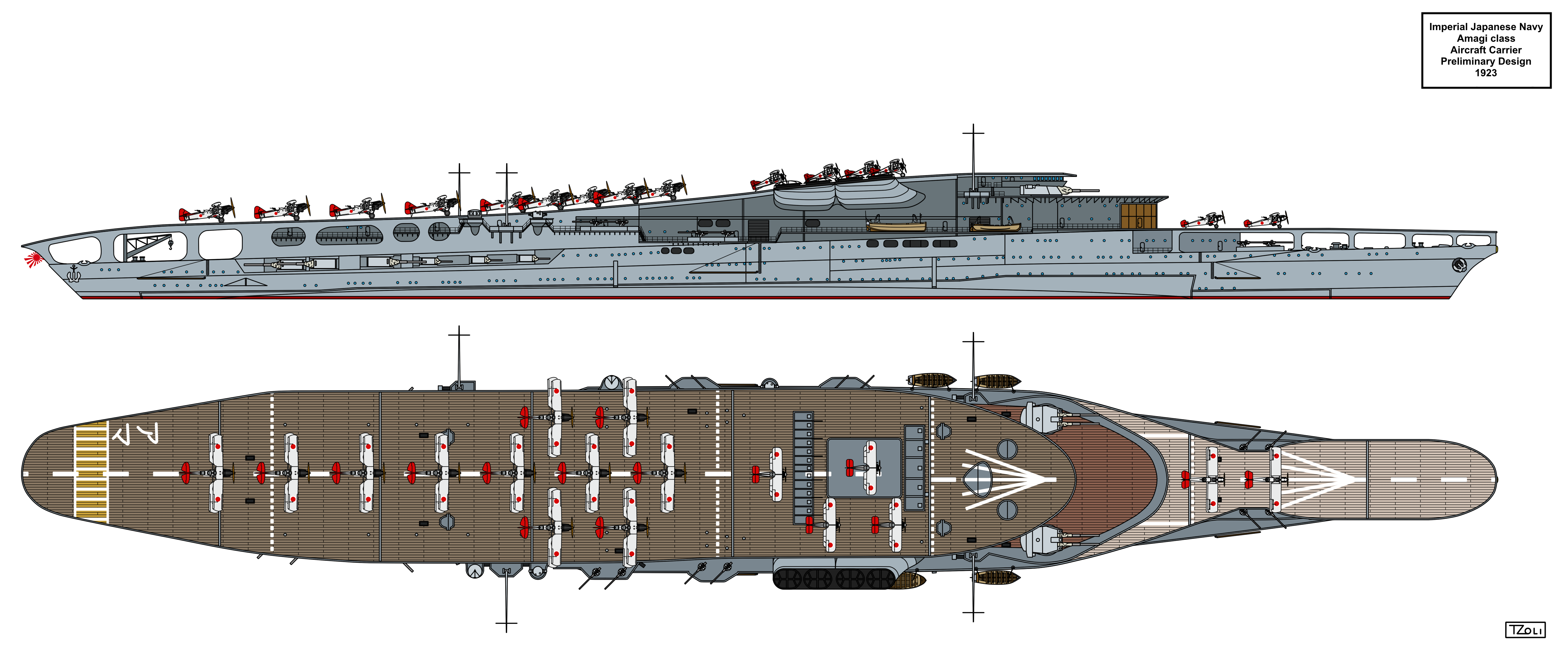
This design is a refinement of the previous one.
By removing the bridge and angling the deck to fully overlap the funnel casing allowed a much larger deck space, on the other hand this seems to be the first design incorporating the idea of a multi deck carrier for the IJN.
This is twin deck carrier design as the the gun deck where the forward twin 20cm turrets are located are not high enough to efficiently operate aircraft (A fighter barely fits between the flight deck and the gun deck space)but this allowed a spacious space allocated for the command bridge.
The main or top flight deck might had been used for the launch of the first strike wave of aircraft, though primary mission was to recover the aircraft for which the almost ski-jump like angle could help slow and stop them, also the single elevator would suggest this mission as well.
The primary take off deck was on the lowest level just above the nose, though due to the AA gun placement there the take-off would be a bit more complicated in strong winds, as there are less space there.
While the original drawing does not show (but the one after this design does) it is logical to assume that the space for the bridge would also house the directors and rangefinder(s) of the main 20cm Guns which would also describe the funnels reduced height to be just barely above the flight deck and thus would not hamper the sight of the directors and rangefinder(s).
The design had the following characteristics:
Dimensions: 235 (pp) 248 (wl) 268,5m (oa) x 38 (at sponsons and funnel) x 6,58m
Displacement: 29.600tons (standard), 33.000tons (full load)
Armour: 127mm Belt, 79mm Deck
Engines: 131.200shp, Gihon steam turbines, 4 shafts
Range: 14.800km at 26km/h (8.000nm at 14knots)
Speed: 57km/h (31,75knots)
Armaments:
2x2 6x1 20cm/50 Type 3 (3rd Year Type No.1) Turreted and Casemated Guns
6x1 12cm/45 Type 10 (10th Year Type) Casemated Guns
12x1 12m/45 Type 10 (10th Year Type) AA Guns
Aircraft capacity: 36-40 planes
Original drawing:
https://iiif.dl.itc.u-tokyo.ac.jp/r...11b81#?c=0&m=0&s=0&cv=1&xywh=-659,0,8261,4927
Amagi Aircraft Carrier Preliminary Design 5

Amagi Aircraft Carrier Preliminary Design 5 by Tzoli on DeviantArt
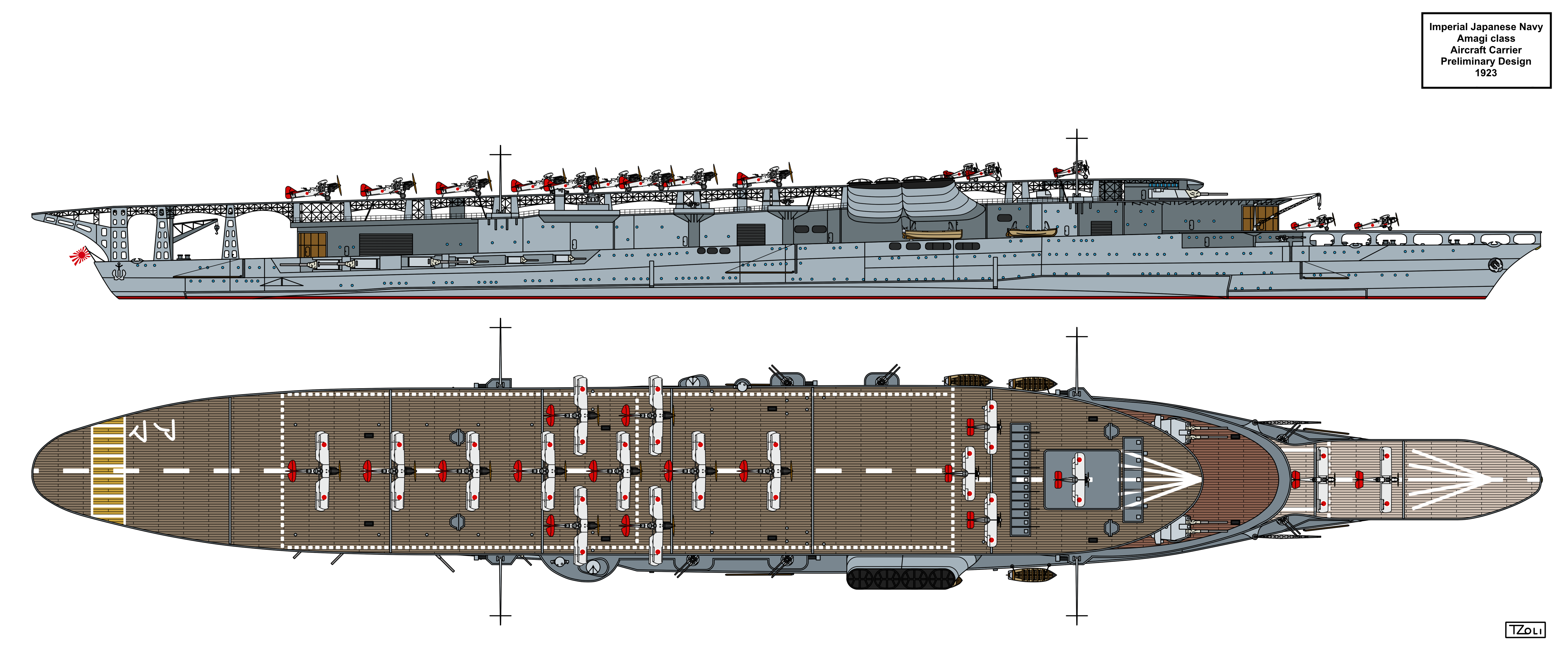
With this next preliminary design the Amagi/Akagi got closer to it's final form. By fixing the large ski like flight deck of the previous design:

Amagi Aircraft Carrier Preliminary Design 4 by Tzoli on DeviantArt
A more refined version of this design exists where the after part of the flight deck squared off, the aft part of the hull cut one deck level and the arrangement of the AA guns became symmetrical.
You clearly see how the final Akagi evolved from these two designs, using the space below the flight deck for hangers and re-arranging the inner hangers structure and layout the capacity for aircraft could be doubled! The make the flight deck free from obstacles and fumes the funnel was bent down and sideways though this resulted the fumes reaching the port side AA guns hence the creation of the first fully enclosed DP-AA mount for the IJN.
The design had the following characteristics:
Dimensions: 235 (pp) 249 (wl) 275m (oa) x 39,5 (at sponsons and funnel) x 6,58m
Displacement: 29.600tons (standard), 33.000tons (full load)
Armour: 127mm Belt, 79mm Deck
Engines: 131.200shp, Gihon steam turbines, 4 shafts
Range: 14.800km at 26km/h (8.000nm at 14knots)
Speed: 57km/h (31,75knots)
Armaments:
2x2 6x1 20cm/50 Type 3 (3rd Year Type No.1) Turreted and Casemated Guns
6x1 12cm/45 Type 10 (10th Year Type) Casemated Guns
6x2 12m/45 Type 10 (10th Year Type) AA Guns
Aircraft capacity: 36-40 planes
Original drawing:
